The answers: the front wheel it lighter, the radial brakes are better, the radial master cylinder is better the forks are lighter and for the L model you have more adjustments in the suspension.
Second, why would you not do this?
You have to get new clipons, you have to have the stem pressed out, you have to find a non-totalled ZX14 frontend or you are a wuss. Sum it up for you?
Okay, Things you absolutely must have: ZX7 and a straight stem from the tripple trees. Zx14 forks, triples and axle.
How to convert the front end of a ZX7 to a ZX14. The reason I did this to my 1994 ZX7 is the new ZX14 forks are fully adjustable and the brakes are radial brakes that have more stopping power and the forks weigh just a little less (I didn’t weigh them, so I don’t have a difference). First you need a ZX7, and the front end of a ZX14. The fork diameters are different so you will need the triple trees, the forks and the calipers. (I think you can get the ZX7 axle to work, But the ZX14 one is nicer and I think may be a little lighter.)
First the ZX7

Next the ZX14 Forks (You need calipers with this) I don't have a picture with calipers.

The first thing that you have to do is remove all the front body work, tank and jack the bike up. You are going to be taking the front end off the bike so you want to make sure that you have it stable and un-movable. You don’t want this thing tipping over on you. I jacked the bike up on the front and rear stands and then I put dunnage (wood blocks) under the bike and checked several times to make sure that the thing would not tip over. You must remember that you are not going to be able to move the bike once you have the front end off. Don’t do this next to a wall or in the center of your garage if your wife is going to come home and want to park the car.
You can get the ZX7 front wheel to work with spacers (you loose your speedometer doing this) as the rotors on both bikes are the same distance apart. I will get to that in a little bit.

The next thing you should do it to get the front wheel lined up. I took the ZX7 wheel off and with the ZX14 forks in the ZX14 triple trees I lined everything up so it fit, the wheel spun and the rotors were dead center in the calipers. (The calipers will need a spacer as the ZX7 disks are larger than the ZX14 ones.) The spacer will need to be 6mm, I just used some stacked washers. The ZX 14 caliper bolts are a little funny, I got three that were 70mm and one that was 60mm in length when I bought my forks. The parts diagram says that they are supposed to be 60mm, but I got a SS one from the parts store and shaved off the flange and it worked fine.
You can see the stacked washers between the caliper and the fork mounting point. The bolt at one end is the one that I shaved the flange off to get it to work with the caliper. You could just uses a hex bolt.
Now that you have all the wheel, caliper and forks parts lined up you have to make sure that all you spacers are correctly situated and the wheel will remain true and straight. I had a 28.3mm spacer on the side of the wheel where the speedometer is and a 17.6mm spacer on the other side. The difference in length is due to the fact that the speedometer is set in a little more. I later moved to a ZX14 front wheel as it matched the Aprilia RSV wheel I have on the back. See another post how to do that. Once You have the wheel in you then need to work out getting the ZX14 forks onto the
Since the forks are different diameters you cannot just swap them out and since they are spaced differently too you can’t build bushings that will work. I tried lots of different ideas and combinations and finally settled with the fact that the best way to do this was going to be push the stem out of each and swap it. The stem on the ZX14 is longer and the lower triple is thinner you need to swap the stems, unless you want to do a whole bunch of machine work.
You will need a shop that can do this for you, it takes a multi ton press and you cannot do this by hand.

You will need to remove the bearings from both sets of triple trees and then have them press the stem out the bottom of the lower. Make sure that you tell the shop a million times to press it out from the top and out the bottom. They ruined one of mine by thinking they knew what they were doing and pressing it out the other way. They come out with about 7 tons of force and the ZX7 stem should go into the ZX14 lower. Now you will have a ZX 14 lower triple tree with a ZX7 stem in it.
Now you have the ZX14 Lower with the ZX7 stem in it. After doing a LOT of measuring and fiddling with the stems and triple trees I finally settled on this ZX7 stem swap because it would prove to be the most effective and require the least amount of parts to be made by a machine shop. I also like to be able to convert it all back if it doesn’t work out. Next you will need a spacer made. If you don’t know the difference between diameter, circumfrance and radius, have someone help you.

I had mine made of aluminum, you will need a disk 51mm in diameter with a hole in the center that is 35mm in diameter. This will make the ring width 8mm as shown in the picture. The height, lay it flat on the table not on the edge of the ring, should be 8mm. (I know in the picture it shows 10mm, but you will need enough space to put the Zx14 dust seal on. I didn’t have enough space to put mine in and I will have to keep an eye on my lower bearings to make sure they don’t get dirty.) Now that I have the ZX14 lower with the ZX7 stem in it the ring needs to be pressed onto the lower part of the stem. This ring will be the spacer so the whole thing comes together properly. I will call this the “Stem Spacer”
I had originally tried a different route with the spacer and it did not work out as well. Since I switched ideas and went with this one I didn’t get a picture of the above idea before it went on the bike.
Now that you have the stem spacer pressed down on the stem you can put the new ZX14 dust seal on. Then put the lower bearing on the stem. You can follow the instructions in your manual how to do this. (Don’t reuse bearings, they are worn and you should just replace them while you are there, they don't cost much) Now you need to replace the bearing race in your steering stem. I used a torch and light hand to get them out.

First I heated the headstock of the frame. (This is a crucial part*** You want to heat/ warm it, not cook it!!!***) I kept the flame moving and just circled the inner steel race. You want to warm up the aluminum so it will expand and the steel will remain cool and not expand. ***You do not want your flame to stop moving around the head stock at all*** If you don’t feel like doing this with a torch, use a hair dryer. It takes longer and you have to make sure to not not heat the bearings.
Then you want to punch it out carefully from the underside of the head stock. You have to be really careful, read the manual and don’t use too much force. You may have to get the special punch tool if you have never done something like this before or have someone with experience help you. You do NOT want to mess up your headstock.
Repeat with the lower bearing race.

Now you have to put the new ones in. I cut the old race and use it as a punch. You must cut it or you will jam it in the headstock and then have to remove it and you will be really mad at your self for not listening to me.
You can see where the old race has a slice cut out with a regular die grinder (make sure to file off any burs that the grinder makes, this will keep your driver from scuffing up the inner surface of the headstock) and is tapped with a hammer to seat to new race in the head stock. The old one will lift right out because the removed section will not allow it to wedge in the headstock. Repeat with lower bearing.

Now that the upper and lower races are in the headstock of the frame the triple trees can be put on and further modifications made to make the key cylinder work with the new triple trees.

Now comes the easy part, putting it all together.
Now you have to make a minor adjustment to the ZX14 upper triple to get the ZX7 key assembly to work properly and the steering to lock like it normally did with the stock ones. It is obvious the mounting points on the ZX14 upper triple are pretty long (They are the black things hanging down in the front). These need to be cut down and a new hole tapped to fit the ZX7 key assembly.

A portion of the key assembly at the bottom must be ground so it will clear the steering lock. If you grind the pin a little, you can get it to go into the hole and lock the steering just like it did when the bike was stock.
Now put on the top nut on and you have your ZX14 triple trees on your frame.
When doing any measurements or adjustments make sure that you have your bearings on the stem and or your measurements will be off and you will have to work around it or fix your errors.
Now, onto the steering stop.
Since the ZX14 and ZX7 have different steering stops, you have to fix this, you want them on your bike. The problem that you have to overcome is the stops on the lower triple tree now don’t reach up high enough to hit the stock steering stop on the frame. The easiest way to get around this is to make the stops reach up higher or the frame stop lower. I tried both, this is the one that works, make the stop lower.

I tapped a hole in the steering stop on the frame and then took a block of 1/2 inch aluminum stock and screwed it to the frame.
I counter sunk the hole in the aluminum block so the bolt would not stick out and then I made sure to use lock-tite to keep it from backing out of the frame hole. The block was 33mm long with the hole in the center of the length, the hole was off to the side width wise to make sure that the bolt was as far into the frame steering stop as I could get it.
You can see how the head of the hex bolt is partially exposed but countersunk so it is flush.


ZX14 has clipons that go above the upper triple tree, the ZX7 has clipons

that go below the triple tree. I wanted to keep the lower ones. The stock ZX7 forks have a larger diameter than the ZX14 forks. But the Zx14 forks have the same upper diameter as the ZX10 of the same year. So, I decided to use Attack Performance Adjustable clipons. I am sure that you could get anything of the same size and get them to work. Both the ZX14 and ZX10 have a 50mm upper tube

diameter. So you could use the Stock ZX10 ones of the same year, but I don’t know the specifics. The Attack ones went right on and looked great. (Picture off Attackperformance.com)
I got the black anodized ones.

You can see in the picture of the blue bike the clipons are above the triple. On my bike it is below. I put a list of the other things that are on the bike. The ZX14 radial front brake master cylinder is was better than stock and costs much less than a Brembo one. I also used the ZX14 upper lock nut, because it looks nicer than the ZX7 one. The ZX10 throttle tube is a straight swap for the ZX7 one and it gives you the same effect as a 1/4 throttle.
( I used 636 cables, but have heard that they do not work on the P model ZX7. You will have to make some from a kit.)

I used a old ZX7 shock mount and bolts as the tool to tighten the front axle, It works great.
Before I did anything else, I made sure that all the settings on the forks were set up so everything was in the middle (Rebound, damping etcetera) and that the forks were rotated in the triple trees so the marks were pointed in the same direction. This allows me to visually look to see if they are at the same setting.
Now that everything is on and tightened down, recheck it again. Spin the wheel and make sure that the rotors are turning and stopping correctly. Then lower the machine onto the new frontend. Check the brakes again just to be sure.

Now you want to roll it around and make sure the weight of the machine is not causing the forks to slide in the triple trees. This is a good indicator that you forgot to tighten something. The reason I keep harping on this is you have to tighten different things on the ZX14 than the ZX7 and if you forget it could really hurt you.
The ZX14 front end is for a bike that weighs about the same as the ZX7 and the stopping power of the lighter front end is much nicer. The front rotors on the Zx14 are smaller, but since they are stock petal rotors they are lighter and with radial brakes and a radial master cylinder, the bike lifts the rear up with only the lightest of pressure on the lever. I have stock ZX14 pads in the calipers.
I am very happy with this over my ZX7 with PM rims, EBC pro-lite rotors and HH pads. Stopping power is increased and now I have fully adjustable forks. (I later decided to go with a ZX14 wheel as well. The PM rims shown here are very light, but the newer ZX14 ones are almost as light and I think they look pretty cool. Plus the ZX14 front wheel matches the Aprilia RSV wheel on the rear of the bike. Here is a picture of the finished front and rear swaps.

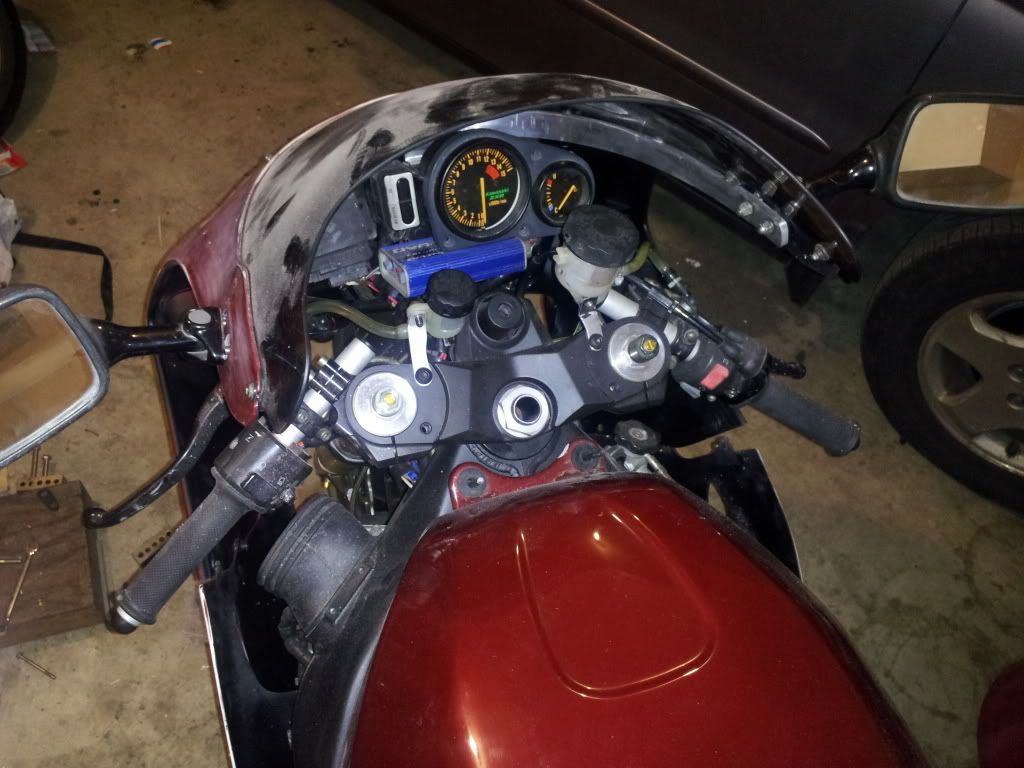
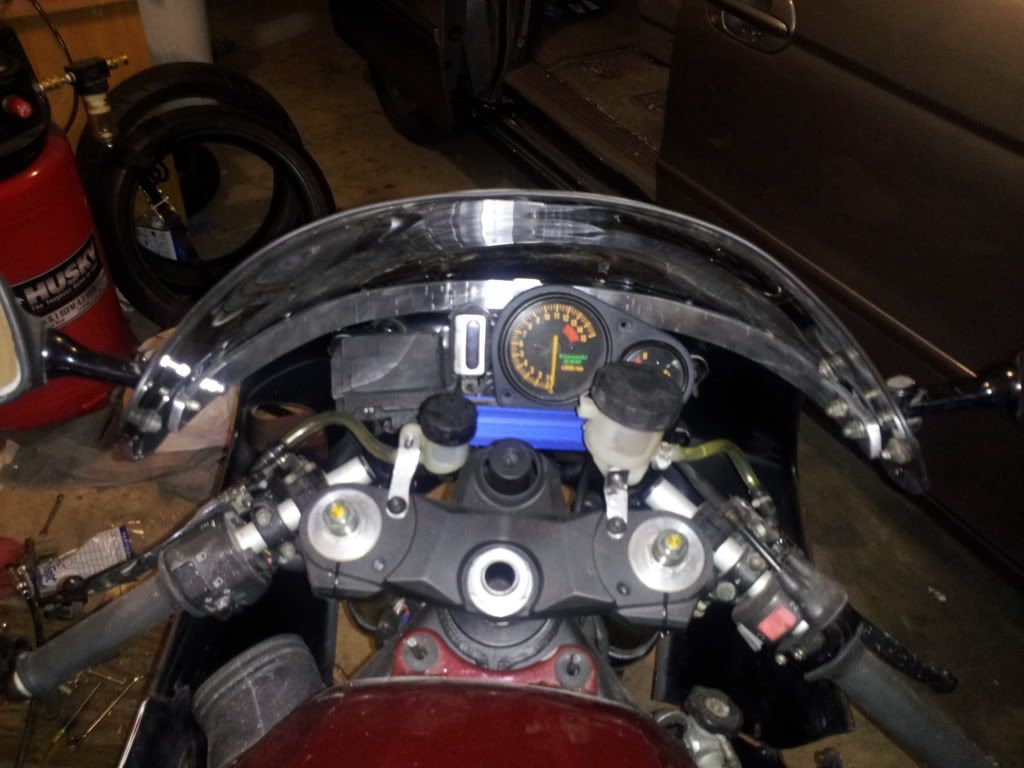
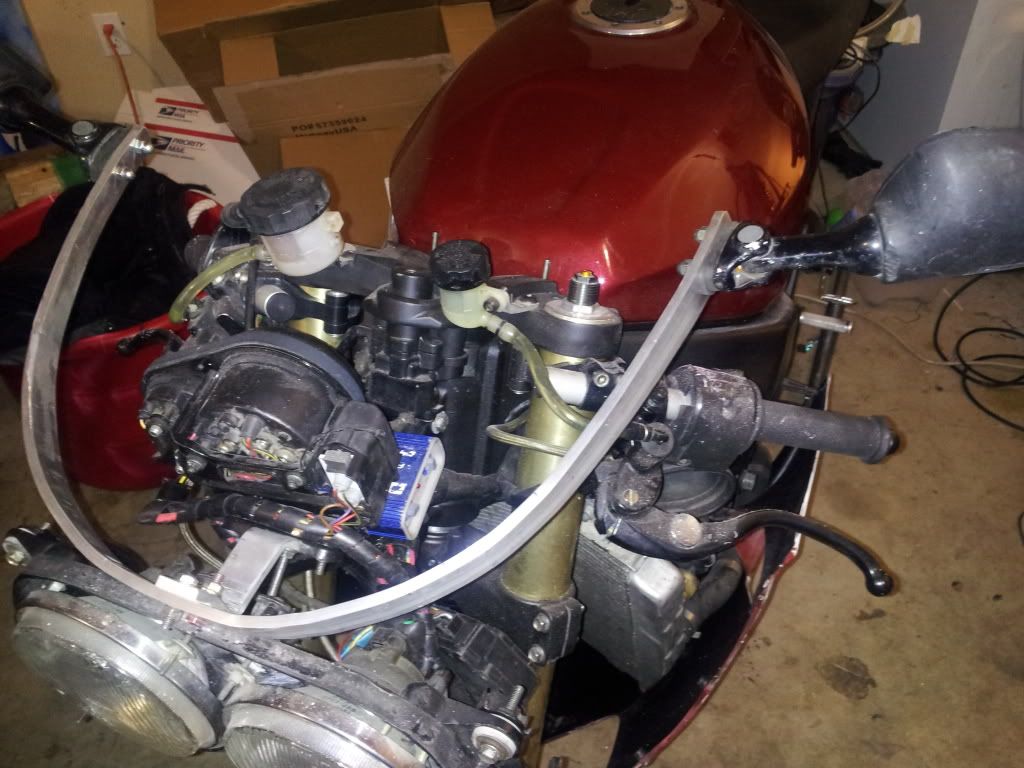 It took quite a bit of thinking and I used a hammer to hit it in the right spots. ;) I can't explain better than that. You have to know how metal works to get it to bend the right way. Then I had to angle the ends out. The fairing isn't vertical where the mirrors attach.
It took quite a bit of thinking and I used a hammer to hit it in the right spots. ;) I can't explain better than that. You have to know how metal works to get it to bend the right way. Then I had to angle the ends out. The fairing isn't vertical where the mirrors attach. 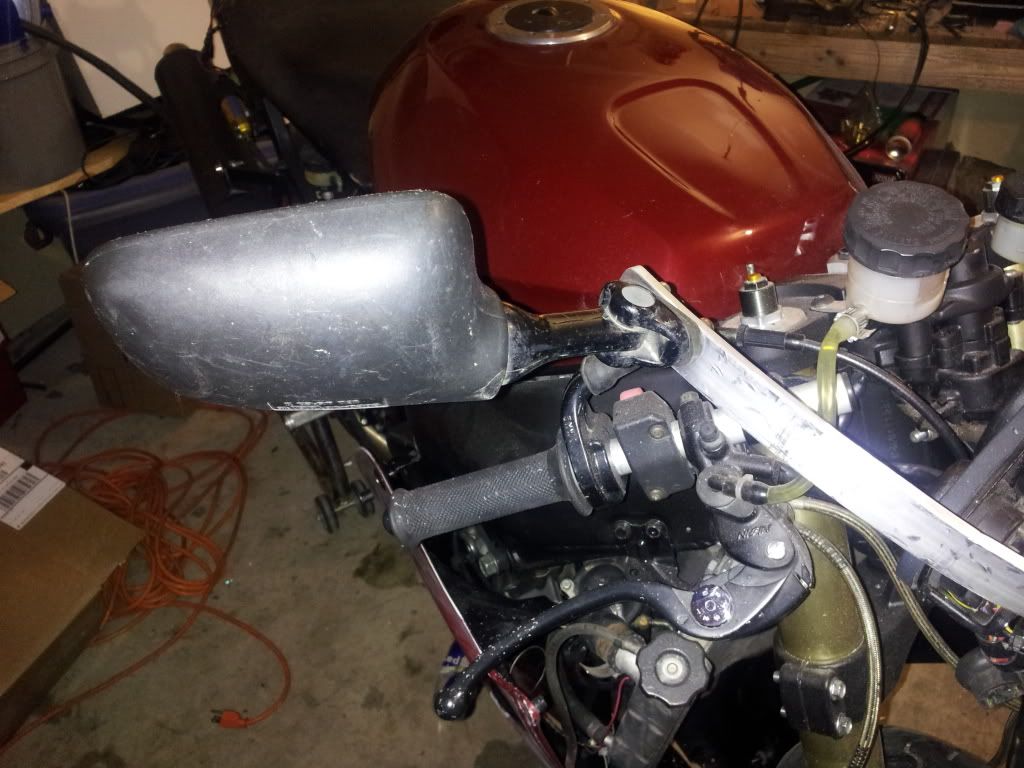

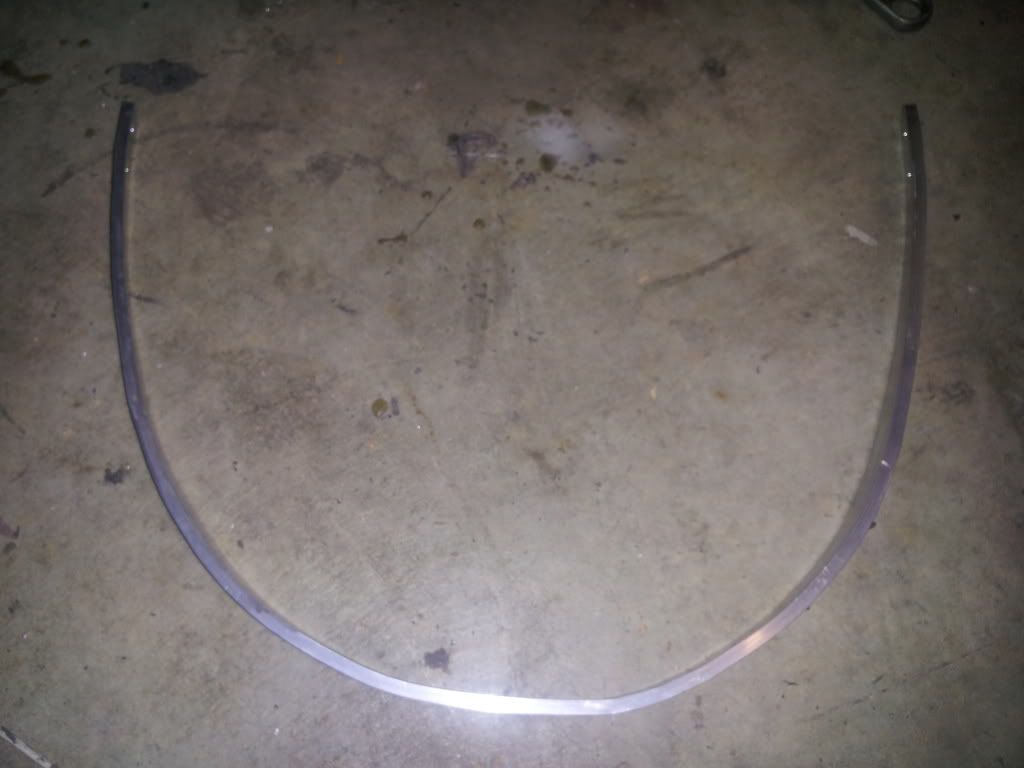
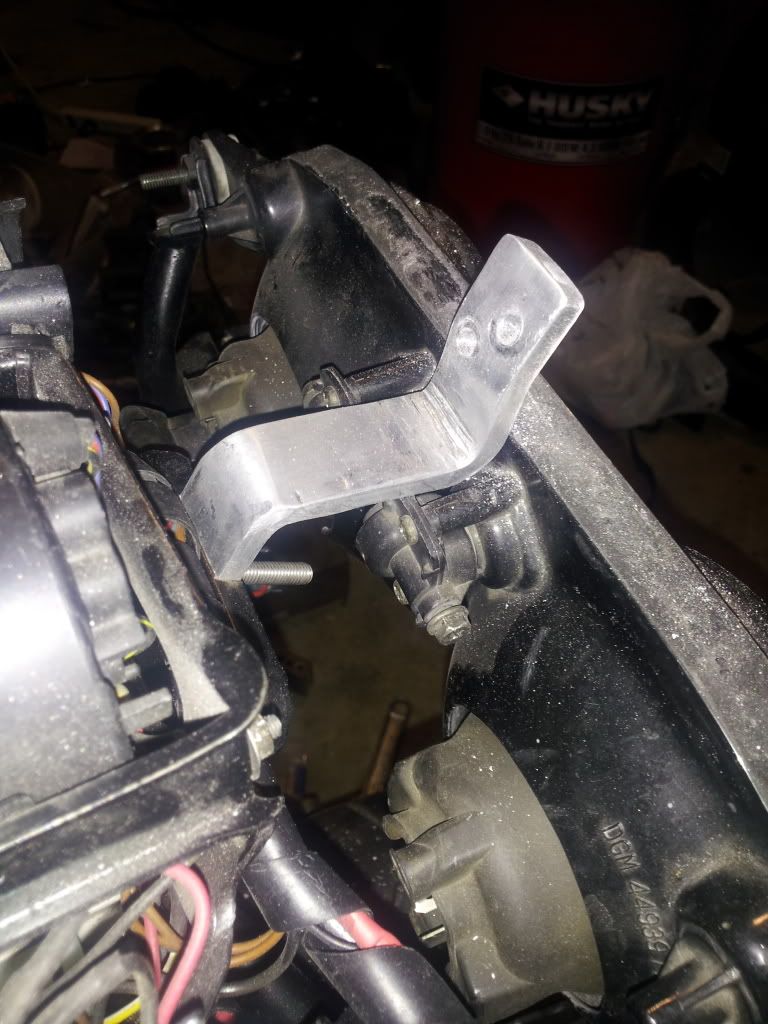
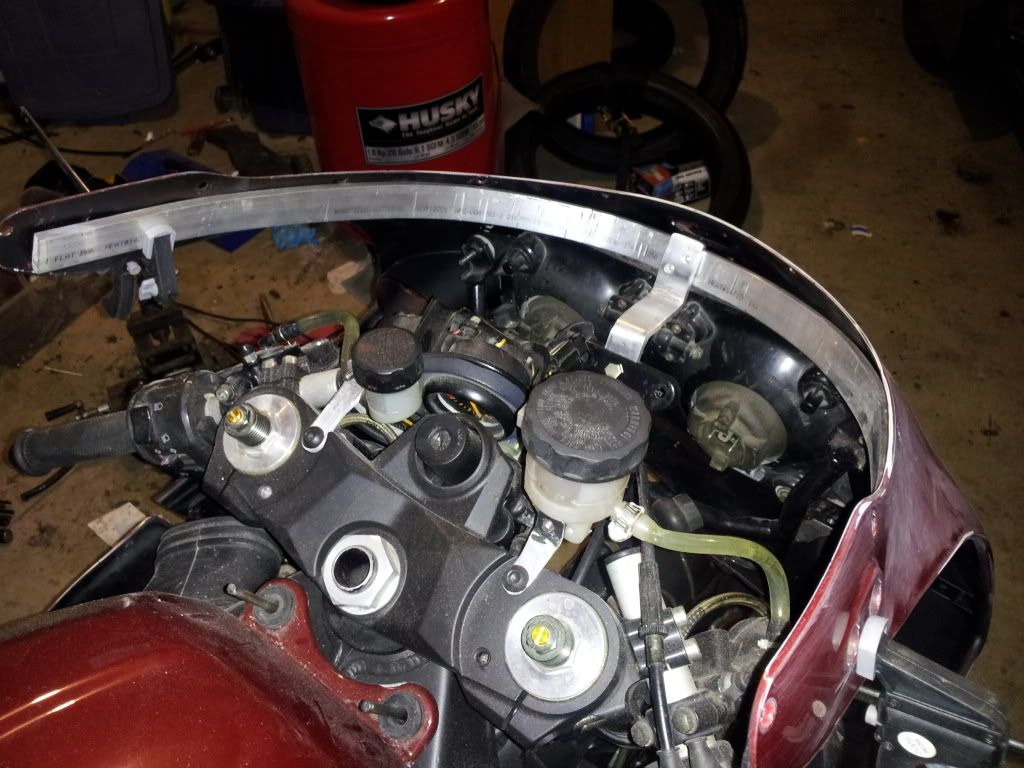
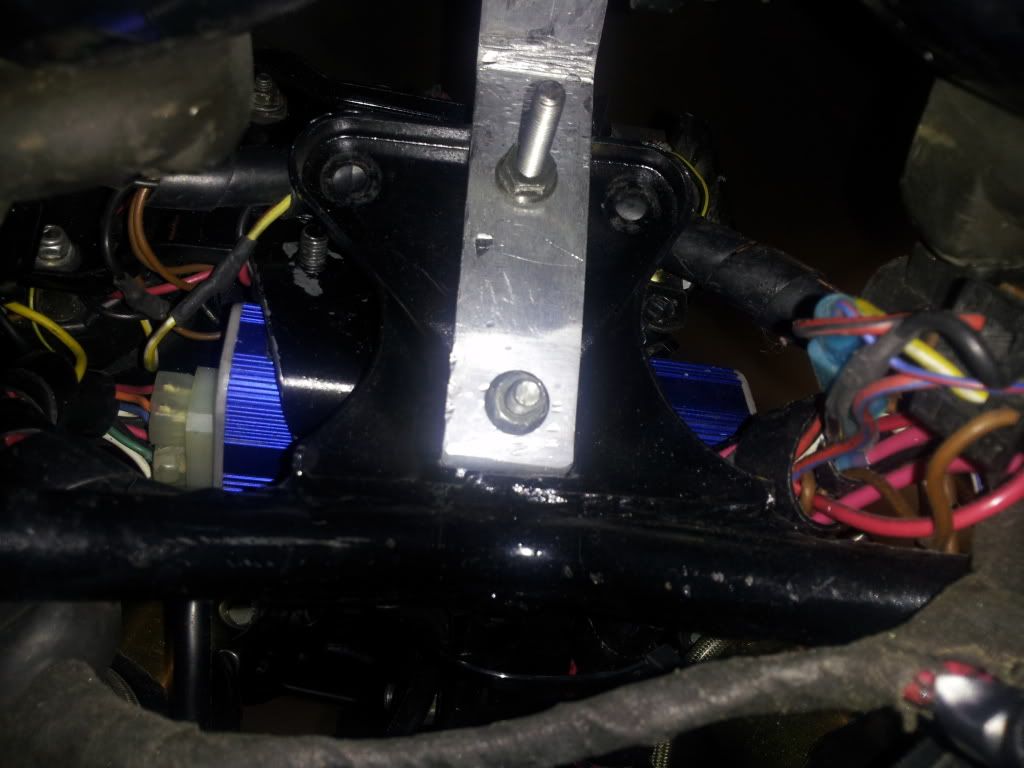
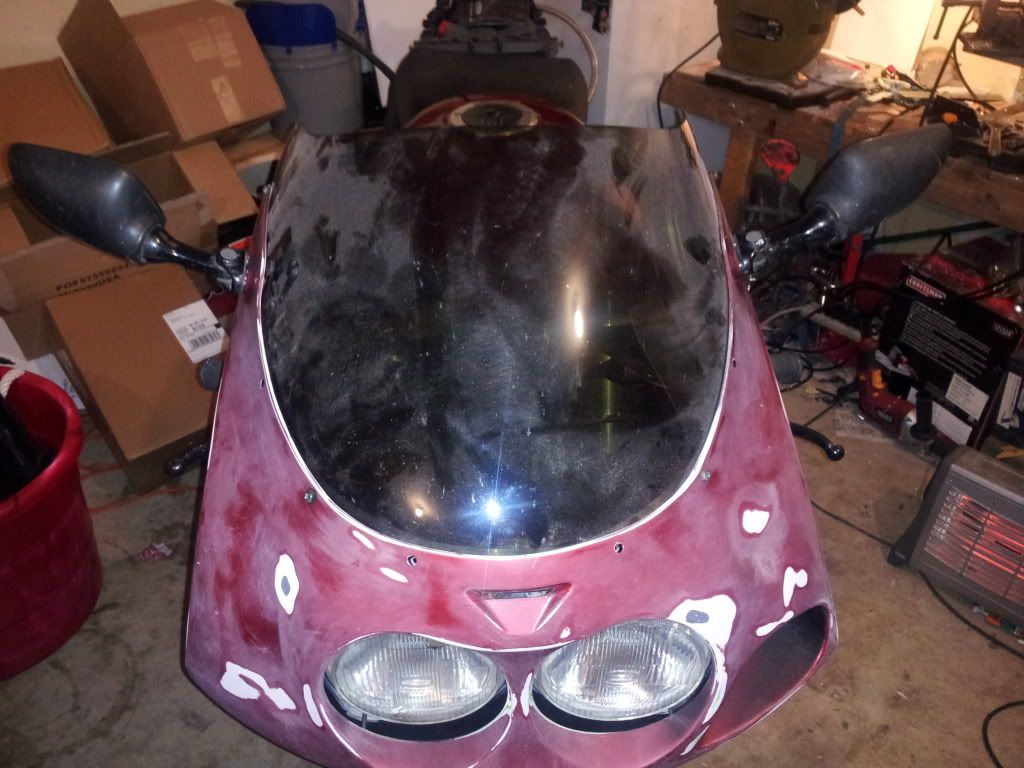
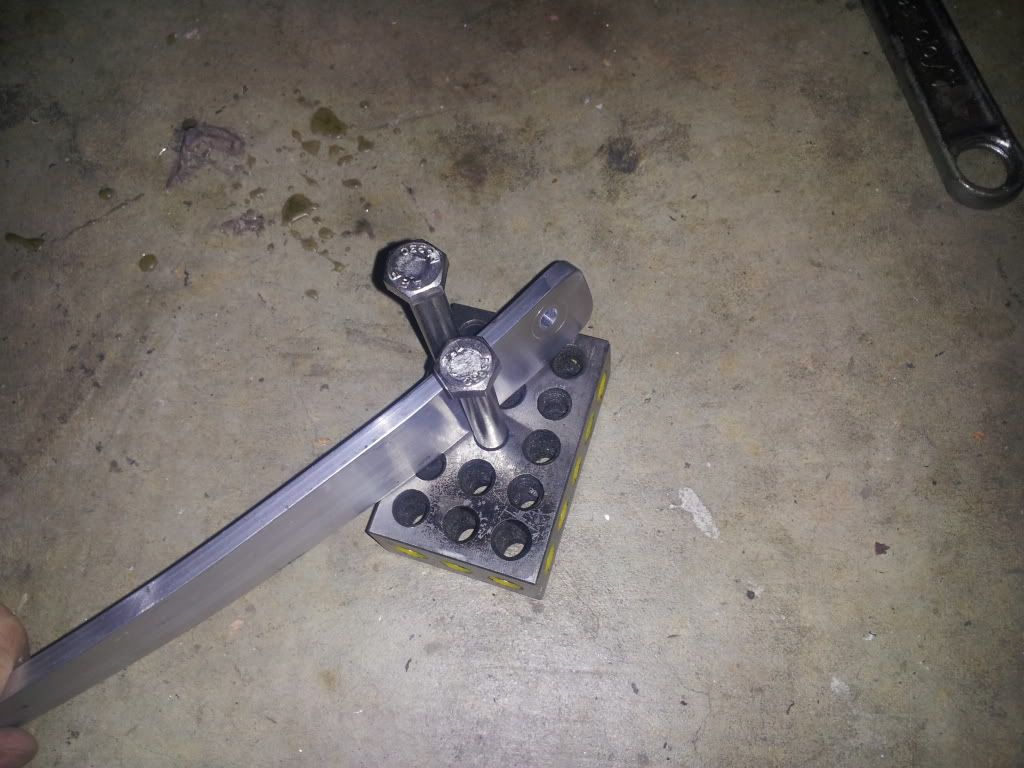

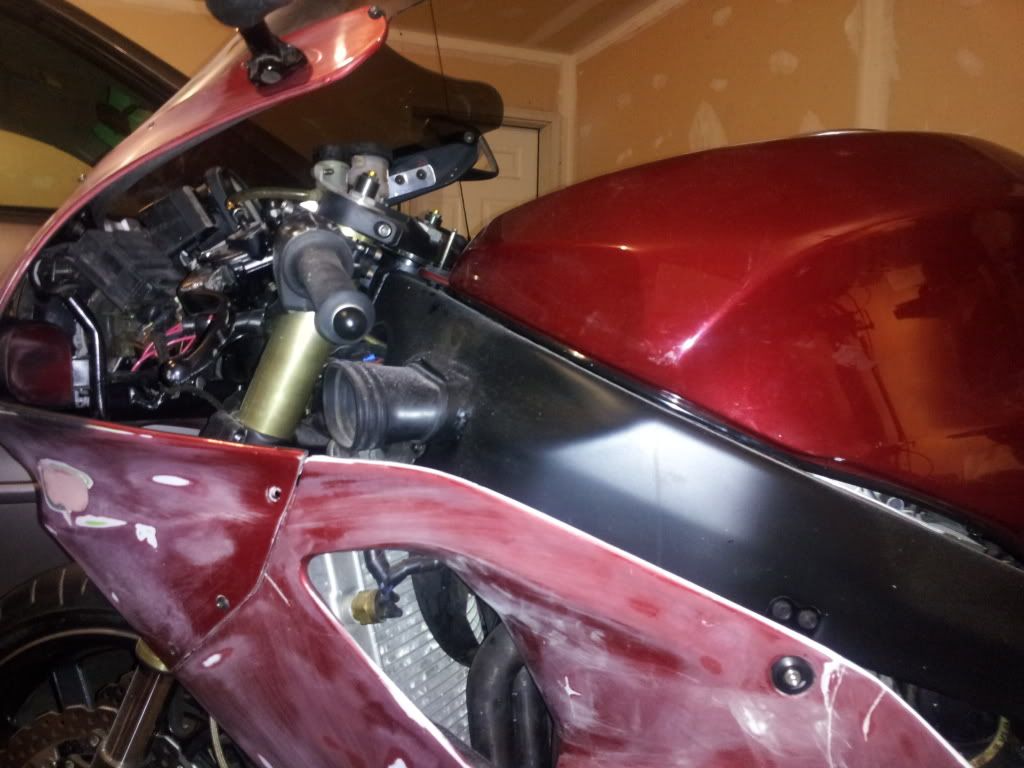

 The two tabs at the back of the airbox must be removed for it to fit under the tank
The two tabs at the back of the airbox must be removed for it to fit under the tank



 This took 15 minutes, but it takes five less minutes each time I take the carbs off by not having swap sockets and walk to my tool box.
This took 15 minutes, but it takes five less minutes each time I take the carbs off by not having swap sockets and walk to my tool box. 


 Just on the inside of the lip of the airbox intake hole I put weather stripping (the sticky side should be perpendicular to the opening or stuck to the little lip you see inside the opening) this allows it to seal.
Just on the inside of the lip of the airbox intake hole I put weather stripping (the sticky side should be perpendicular to the opening or stuck to the little lip you see inside the opening) this allows it to seal. 








 Next the ZX14 Forks (You need calipers with this) I don't have a picture with calipers.
Next the ZX14 Forks (You need calipers with this) I don't have a picture with calipers. The first thing that you have to do is remove all the front body work, tank and jack the bike up. You are going to be taking the front end off the bike so you want to make sure that you have it stable and un-movable. You don’t want this thing tipping over on you. I jacked the bike up on the front and rear stands and then I put dunnage (wood blocks) under the bike and checked several times to make sure that the thing would not tip over. You must remember that you are not going to be able to move the bike once you have the front end off. Don’t do this next to a wall or in the center of your garage if your wife is going to come home and want to park the car.
The first thing that you have to do is remove all the front body work, tank and jack the bike up. You are going to be taking the front end off the bike so you want to make sure that you have it stable and un-movable. You don’t want this thing tipping over on you. I jacked the bike up on the front and rear stands and then I put dunnage (wood blocks) under the bike and checked several times to make sure that the thing would not tip over. You must remember that you are not going to be able to move the bike once you have the front end off. Don’t do this next to a wall or in the center of your garage if your wife is going to come home and want to park the car.





















